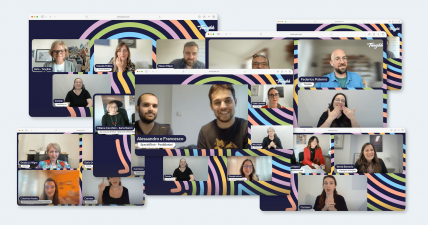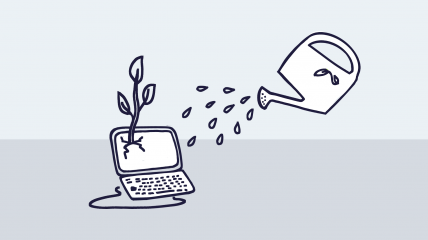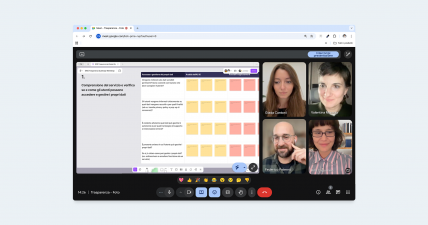Thinking
What we learned from "Fuori Rete" about the Social Digital Divide
A year of listening, sharing, and adopting new perspectives to imagine more inclusive and human services

At the start of the year, when we chose the theme for Inspiration, we asked ourselves: What does it mean to talk about the digital divide today?
We knew the infrastructural gap - the lack of connection, devices, or access - was only part of the problem. The other side is more subtle and harder to see. It concerns trust, autonomy, understanding, and whether people feel included by the digital services that now permeate everyday life.
To address this issue, we chose to seek out voices rather than "professional" experts. Voices of people who experience the digital divide daily or work to bridge it. We chose to listen before designing. We gathered stories, experiences, and points of view that are often very different yet united by the same question: Who gets left behind in the digital transition, and why?
It hasn’t been an easy journey. We heard tough stories, observed contradictions, and collected uncomfortable questions. While we didn't find definitive answers, we found something even more valuable: new lenses through which to view our work. Most importantly, we found confirmation that this issue affects all of us every day, even when we don’t realize it.
For those of us who design digital services, these conversations served as a mirror, helping us understand where our services might be creating distance instead of building access. They showed us how we can do better, where we’re falling short, and what responsibilities we unknowingly carry.
In this article, we share some takeaways - not conclusions, but openings. We hope these signals can guide those who design, govern, or question the role of digital technology in human relationships.
Let's not forget what we learned
The digital divide is systemic, not generational
It doesn't only affect older people or those without internet access. Older adults often struggle with technology, which can feel stigmatizing. However, younger generations also experience the divide, often without realizing it. They believe they know technology well, but don’t understand their devices' potential or have access to many useful services.
This demonstrates how the digital divide can affect even those we consider "digital natives". The digital divide is a complex, layered phenomenon fueled by educational poverty, language barriers, economic hardship, outdated technology, distrust, and fear. It’s not an individual problem, but a social one. It can’t be solved with technical fixes alone but rather with inclusive policies that recognize and address these factors.
We’re working in schools, meeting with fourth- and fifth-year high school students. They’re great with social media, but they don’t know much about digital identity. They often don’t realize how many things they can do with their devices, such as using them as digital IDs or student cards.
Without relationships, there is no inclusion
Human support is often the only way to make a service accessible. The most effective digital inclusion projects, like Digitale Facile and Pan e Botoni, aren’t the ones with the latest technology; they're the ones that know how to welcome, listen to, and reassure people.
Physical presence builds trust, connection, and dignity. It’s an investment in social capital, not a cost.
Without that trusted relationship, people would never open up. They wouldn’t tell you they don’t understand. Digital can be humiliating.
Autonomy requires time, mistakes, and feedback
Many older adults don’t want to "bother their kids" every time they encounter a digital challenge. They aren't asking for quick fixes; they want tools to help them understand and overcome challenges independently.
Effective digital inclusion programs don't just teach how to use an app; they offer reusable strategies and encourage trial and error, note-taking, and experimentation. That’s how technology stops being scary and becomes empowering.
At the end of the course, the women showed us their notebooks full of handwritten notes. It’s their way of holding on to what they’ve achieved.
Every interface is a political choice
Our design decisions, such as choosing an authentication method or designing a support form, can make interactions so complex that many users give up.
Designing a service means deciding who to include and exclude, and under what conditions. Design isn’t neutral: it reflects the biases of those who create it and can reinforce inequality instead of reducing it.
One helpful exercise to avoid these pitfalls is to move beyond personas and standard scenarios. Instead, we can use edge cases to challenge ourselves with more realistic and complex archetypes. For example, what happens to an interaction flow if the main persona doesn't speak the language? What if they don't have valid documents? What if they lost their glasses and couldn’t see well? What if the user is a migrant, incarcerated, or unhoused?
That’s where the true public value of digital design is measured.
If we assume that digital technology is the solution for everyone, then we’re assuming that everyone has the same conditions for accessing it. They don’t. And designers have enormous power.
Education alone isn't enough, we need support
We live in a world where information is abundant, but understanding is fragile. Those with fewer tools risk feeling excluded or overwhelmed. We need ongoing training that is creative and accessible.
It's not just about courses; it's also about presence, appropriate language, practical examples, and a variety of formats. The real hunger isn’t just for skills, but also for someone who helps you feel less alone in the process.
The problem isn't just a lack of skills; it's also digital loneliness. You need someone who’s there to help you find your way.
No one is saved alone, not even in digital
No institution can address the digital divide alone. Successful initiatives are born when public institutions, third-sector groups, local associations, and expert communities (including designers and tech professionals) collaborate.
However, one crucial piece is often missing: the active involvement of the most vulnerable people in service design.
Not as users, but as co-authors. They should be beta testers of a society meant to serve everyone.
The most vulnerable people aren’t involved in the design process, and that’s a huge mistake. They should be the first to test services, not the last.
We also need a physical fallback
While the social digital divide is characterized by distance, inaccessibility, and exclusion, service design provides the big-picture thinking necessary to anticipate and counteract these effects.
Designing hybrid physical-digital experiences informed by the scenarios we explored can help build bridges that reduce inequality and bring people closer.
A digital system - especially one that ignores human vulnerability - can hardly offer the same level of support, guidance, and care that a person can.
What we actually did
Each Fuori Rete session was, first and foremost, an opportunity to listen, connect, and build trust. It wasn't a webinar. It wasn't just another item on the calendar. It was an act of care. Like all acts of care, it generated connections between people, stories, and questions.
We chose to donate part of the speakers’ fees to organizations working on inclusion and social justice. In total, we donated over one thousand euros: approximately half to WeWorld, especially for their Gaza emergency response, and the remainder to local groups such as Progetto Itaca Rimini, Caritas, and Legalo al Cuore Onlus.
Sometimes, the guests themselves suggested projects to support, and in other cases, we chose together to direct the funds to WeWorld.
Thanks to everyone who spoke, listened, and helped circulate these ideas. Thank you to those who asked tough questions, shared concrete examples, and helped us see what’s usually overlooked.
Building social capital today also means taking time to build relationships, give back, and generate trust. Even in the digital world. Even among people who are very different from us.
What's next?
We didn’t find a definitive answer to the digital divide.
However, we discovered that the real question is not only "Who’s being left out?" but also "What can we do to close the gap?"
Another underlying question matters for business, too: When people are excluded, they’re lost users and customers. This isn't our primary motivation, but it's a reminder that the digital divide has far-reaching effects beyond social inclusion.
Inspiration isn’t just a content series. It’s an ongoing listening practice that evolves with us. It's a way to maintain an open space for community, reflection, and responsibility.
We invite you to rewatch the talks (italian language only), share a story, or tell us about your experience. If you see yourself in the voices we featured or the struggles we described, know that you are not alone. Building networks means creating spaces where the unheard can speak.
Depending on how it’s designed, digital can include or exclude. As designers, citizens, and human beings, we will keep asking ourselves what kind of digital world we’re helping to build.


